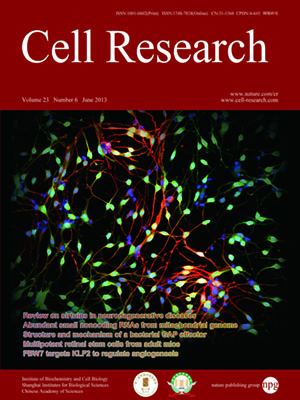
Volume 23, No 6, Jun 2013
ISSN: 1001-0602
EISSN: 1748-7838 2018
impact factor 17.848*
(Clarivate Analytics, 2019)
Volume 23 Issue 6, June 2013: 835-850
ORIGINAL ARTICLES
Dlic1 deficiency impairs ciliogenesis of photoreceptors by destabilizing dynein
Shanshan Kong1, Xinrong Du1, Chao Peng1, Yiming Wu1, Huirong Li2, Xi Jin2, Ling Hou2, Kejing Deng1, Tian Xu1,3 and Wufan Tao1
1State Key Laboratory of Genetic Engineering and Institute of Developmental Biology and Molecular Medicine, School of Life Science, Fudan University, Shanghai 200433, China
2Developmental Cell Biology and Disease Program, State Key Laboratory Cultivation Base and Key Laboratory of Vision Science of Ministry of Health, Wenzhou Medical College, Wenzhou, Zhejiang 325003, China
3Howard Hughes Medical Institute, Department of Genetics, Yale University School of Medicine, New Haven, CT 06536, USA
Correspondence: Wufan Tao, Tel: +86-21-65643949; Fax: +86-21-65642111 E-mail: wufan_tao@fudan.edu.cn; Tian Xu, Tel: 203-767-2623; Fax: 203-767-1762(tian.xu@yale.edu)
Cytoplasmic dynein 1 is fundamentally important for transporting a variety of essential cargoes along microtubules within eukaryotic cells. However, in mammals, few mutants are available for studying the effects of defects in dynein-controlled processes in the context of the whole organism. Here, we deleted mouse Dlic1 gene encoding DLIC1, a subunit of the dynein complex. Dlic1−/− mice are viable, but display severe photoreceptor degeneration. Ablation of Dlic1 results in ectopic accumulation of outer segment (OS) proteins, and impairs OS growth and ciliogenesis of photoreceptors by interfering with Rab11-vesicle trafficking and blocking efficient OS protein transport from Golgi to the basal body. Our studies show that Dlic1 deficiency partially blocks vesicle export from endoplasmic reticulum (ER), but seems not to affect vesicle transport from the ER to Golgi. Further mechanistic study reveals that lack of Dlic1 destabilizes dynein subunits and alters the normal subcellular distribution of dynein in photoreceptors, probably due to the impaired transport function of dynein. Our results demonstrate that Dlic1 plays important roles in ciliogenesis and protein transport to the OS, and is required for photoreceptor development and survival. The Dlic1−/− mice also provide a new mouse model to study human retinal degeneration.
10.1038/cr.2013.59
FULL TEXT | PDF
Browse 2372


